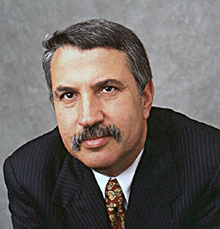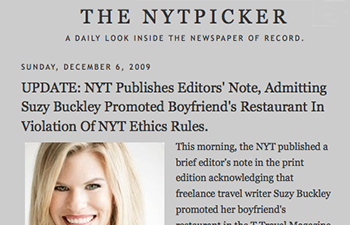On Sunday, the New York Times published an Editors’ Note detailing a conflict of interest:
The “Place” feature about Miami in the T magazine travel issue on Nov. 22 included a reference to the 8 oz. Burger Bar. The writer has had a long personal relationship with a co-owner of the restaurant; had editors known of that connection, the restaurant would not have been included in the article.
One thing the note didn’t disclose was that this personal relationship was first identified and publicized by the NYTPicker, an anonymous group blog (and Twitter account) that has been keeping tabs on the New York Times for a little over a year. During its relatively brief existence, the site’s hundreds of posts have demonstrated that its authors have a breadth and depth of insight into the paper.
Just last week, the NYTPicker raised some serious and legitimate questions about a new book edited by Gretchen Morgenson, the Times’ Pulitzer Prize-winning business columnist.
The NYTPicker has also demonstrated a talent for spotting overused phrases by Times headline writers; it celebrated the work of Times journalist Robin Toner after she died late last year; and it has been diligent about tracking the work — and titles — of technology columnist David Pogue.
If you’re interested in the Times, you need to read the NYTPicker. Here’s how the site describes itself and the people who write for it:
This website devotes itself exclusively to the goings-on inside the New York Times — the newspaper and the institution itself. Written by a team of journalists who prefer to work in anonymity, The NYTPicker reports daily on the internal workings of the nation’s top newspaper, and comments on its content.
The site’s authors refused to provide even a few hints as to their identities, but they did, for the first time, agree to answer questions via email. As a result, we now know that six people write for the site, they describe themselves as “reporters,” and they aren’t impressed with the work of Thomas L. Friedman. On top of that, they’re a pretty funny group.
Q&A
Why did you start the site?
We came up with the name “NYTPicker” and realized it didn’t really work for our soft-core porn idea.
How many people visit the site per day?

We average about 1,000 to 1,500 hits a day, but have had a few 10,000-hit days. Depends on what we write about, who links to us, and whether we use that sexy photo of Maureen Dowd in a lounge chair.
Do you get a lot of traffic from folks inside the Times?
Um, yes.
Do you consider the site to be a watchdog of the Times? Why or why not?
We’re not media critics. We’re journalists who love the NYT and hope our stories improve it. We report on aspects of coverage NYT readers might not otherwise know or think about.
One common theme on the site seems to be conflicts of interest. You often point out how the personal and professional relationships of Times reporters and editors appear to play a role in coverage. Do you see this as a big problem at the paper? And do you think it’s worse at the Times compared to other media organizations?
We’re not writing an institutional history of the NYT — we’re covering it day to day. We point out the problems when we find them. They don’t seem to be going away.
You often display a decent amount of insider knowledge. A recent example would be the fact that you knew about Times freelancer Suzy Buckley’s old boyfriend. Does this kind of information come from sources inside the Times? Or do your contributors have a handle on this stuff on their own?
We’re reporters. We don’t talk about our sources.
How has the site changed over the course of its first year of publishing?
We’re more selective about posts now than in the beginning. We only publish when we’ve got a story, or angle, you won’t find anywhere else.
Is there one post that you’d highlight as your best work?
We liked the story we did on Brad Stone’s page-one trend piece, the one that was filled with quotes from friends and colleagues. We were also proud of our stories about the NYT’s deeply-flawed Caroline Kennedy coverage, and our reporting on the Maureen Dowd plagiarism scandal. We still haven’t gotten any comment from the NYT about whether the paper investigated Dowd’s explanation, which wasn’t very plausible.
Our biggest scoop? Probably when we discovered that the anagram for “New York Times” was “Write, Monkeys.”
Have you received any official reaction from the Times?
When Catherine Mathis, the NYT’s recently-departed spokeswoman, answered our emails, she always wrote, “Dear NYTPicker.” That was sweet. We liked her.
What is your biggest issue of concern at the paper right now?
That changes every day. We read the paper every morning with an open mind, looking for stories, angles, ideas, and funny bylines. The NYT used to have funnier bylines. We miss Serge Schmemann. We hope we’ll be seeing more stories from David Belcher.
We’ve also been working very hard on a story about the difference between Kirk Johnson and Dirk Johnson. That should be ready shortly.
Who is the paper’s best columnist and why?
Philip Adler on bridge. Last week he ended his column with the line, “The imponderables of bridge keep us thinking and playing.” That’s freaking genius.

Who is its worst and why?
Thomas L. Friedman. Do we really need to explain?
You recently contacted sports editor Tom Jolly and received an official comment from him. Did he have any specific reaction to being contacted by your site? Was he familiar with it?
We asked him a few questions, and he answered. Simple as that.
Where does the Times excel in terms of its journalism, and where does it fall short?
Too many stories about texting and driving. We get it. It’s dangerous. We’ll stop.
Can you give me a preview of the top candidates for the Worst NYT Story of 2009 award?
It all depends on what happens next in “The Puppy Diaries.”
Why do you need to remain anonymous?
Mom thinks we’re doing our homework and we don’t want to get in trouble.
I noticed that a comment on your one-year anniversary post read, “Congratulations on a year of anonymity and cowardice!” Do you regularly face criticism for this decision?
Once every few weeks, social media editor Jennifer Preston calls us cowards and invites us to lunch. Otherwise, not really.
How many people write for the blog?
Six.
What can you tell me about them? (Where at the Times did they work, did any of you take buyouts, are any of you current employees, etc.?)
We’re all very attractive.
How many people are answering these questions?
Four. Two of us have declined to comment.
Craig Silverman is an award-winning journalist and author and an associate editor at MediaShift and Idea Lab. He is the founder and editor of Regret The Error, the author of Regret the Error: How Media Mistakes Pollute the Press and Imperil Free Speech, and a weekly columnist for Columbia Journalism Review. Follow him on Twitter at @CraigSilverman.

